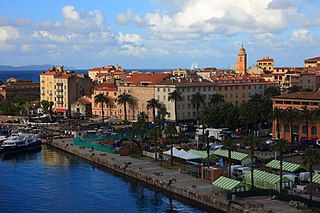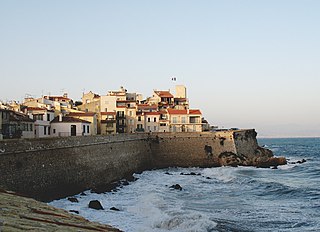
Ajaccio is a French commune, prefecture of the department of Corse-du-Sud, and head office of the Collectivité territoriale de Corse. It is also the largest settlement on the island. Ajaccio is located on the west coast of the island of Corsica, 210 nautical miles (390 km) southeast of Marseille.

A citadel is the core fortified area of a town or city. It may be a castle, fortress, or fortified center. The term is a diminutive of "city", meaning "little city", because it is a smaller part of the city of which it is the defensive core. Ancient Sparta had a citadel, as did many other Greek cities and towns.

Antibes is a coastal city in the Alpes-Maritimes department of southeastern France, on the Côte d'Azur between Cannes and Nice.

The French Riviera is the Mediterranean coastline of the southeast corner of France. There is no official boundary, but it is usually considered to extend from Toulon, Le Lavandou or Saint-Tropez in the west to Menton at the France–Italy border in the east. The coast is entirely within the Provence-Alpes-Côte d'Azur region of France. The Principality of Monaco is a semi-enclave within the region, surrounded on three sides by France and fronting the Mediterranean. Riviera is an Italian word that corresponds to the ancient Ligurian territory, wedged between the Var and Magra rivers. The Côte d'Azur or French Riviera, is a nickname given by France to the County of Nice after its annexation in 1860, because the rain and the Mistral were stopped by the Alps and the climate was similar to that of the north of Italy, even in winter, with a sky as blue as its sea, the French Riviera. When the Mistral and the Tramontane are blowing, this provokes an upwelling phenomenon between Languedoc and Provence: they push the surface waters out to sea and bring deeper, cooler waters up to the seaside. Consequently, on these beaches, the temperature of the Mediterranean can be very cool in summer depending on the wind regime. This phenomenon is observed very little or not on the coast between the French Riviera and the Italian Riviera. After the 2000s it was extended to the rest of Southern France, although the geography, culture or climate is different. The County of Nice is a mountainous area like Italy which stands out from the South of France. While the Saharan warm wind Sirocco blows over Italy, the cold wind Mistral blows over the south of France. As the County of Nice is protected by the Alps, it has a northern Italian climate. This corresponds to the mountain range of the Apennines and Ligurian Alps and located between the rivers of Var and Magra.

The Arg-e Bam, located in the city of Bam, Kerman Province of southeastern Iran, is the largest adobe building in the world. The entire building was a large fortress containing the citadel, but because the citadel dominates the ruins, the entire fortress is now named Bam Citadel.

Cimiez is an upper class neighborhood in Nice, southern France. The area contains the Musée Matisse and the ruins of Cemenelum, capital of the Ancient Roman province Alpes Maritimae on the Ligurian coast. Cemenelum was an important rival of Nice, continuing to exist as a separate city till the time of the Lombard invasions. The ruins include an arena, amphitheater, thermal baths, and paleochristian basilica.

Villefranche-sur-Mer is a commune in the Alpes-Maritimes department in the Provence-Alpes-Côte d'Azur region on the French Riviera and is located south-west of the Principality of Monaco, which is just west of the French-Italian border.
Las, or Laas (Λάας), or La (Λᾶ), was one of the most ancient towns of Lakedaimonia, located on the western coast of the Laconian Gulf. It is the only town on the coast mentioned in the Periplus of Pseudo-Scylax between Taenarus and Gythium. The Periplus speaks of its port; but, according to Pausanias, the town itself was distant 10 stadia from the sea, and 40 stadia from Gythium. In the time of Pausanias the town lay in a hollow between the three mountains, Asia, Ilium, and Cnacadium; but the old town stood on the summit of Mt. Asia. The name of Las signified the rock on which it originally stood. It is mentioned by Homer in the Catalogue of Ships in the Iliad, and is said to have been destroyed by the Dioscuri, who hence derived the surname of Lapersae. There was also a mountain in Laconia called Lapersa.

Gellért Hill is a 235 m (771 ft) high hill overlooking the Danube in Budapest, Hungary. It is located in the 1st and the 11th districts. The hill was named after Saint Gerard who was thrown to death from the hill. The famous Hotel Gellért and the Gellért Baths can be found in Gellért Square at the foot of the hill, next to Liberty Bridge. The Gellért Hill Cave is also located on the hill, facing the hotel and the Danube.

São Jorge Castle is a historic castle in the Portuguese capital of Lisbon, located in the freguesia of Santa Maria Maior. Human occupation of the castle hill dates to at least the 8th century BC while the first fortifications built date from the 1st century BC. The hill on which São Jorge Castle stands has played an important part in the history of Lisbon, having served as the location of fortifications occupied successively by Phoenicians, Carthaginians, Romans, and Moors, before its conquest by the Portuguese in the 1147 Siege of Lisbon. Since the 12th century, the castle has variously served as a royal palace, a military barracks, home of the Torre do Tombo National Archive, and now as a national monument and museum.

The Citadel of Cairo or Citadel of Saladin is a medieval Islamic-era fortification in Cairo, Egypt, built by Salah ad-Din (Saladin) and further developed by subsequent Egyptian rulers. It was the seat of government in Egypt and the residence of its rulers for nearly 700 years from the 13th to the 19th centuries. Its location on a promontory of the Mokattam hills near the center of Cairo commands a strategic position overlooking the city and dominating its skyline. At the time of its construction, it was among the most impressive and ambitious military fortification projects of its time. It is now a preserved historic site, including mosques and museums.

Sagunto ([saˈɣunto] is a city in Eastern Spain, in the modern fertile comarca of Camp de Morvedre in the province of Valencia. It is located c. 30 km north of Valencia, close to the Costa del Azahar on the Mediterranean Sea.

The Citadel of Aleppo is a large medieval fortified palace in the centre of the old city of Aleppo, northern Syria. It is considered to be one of the oldest and largest castles in the world. Usage of the Citadel hill dates back at least to the middle of the 3rd millennium BC. Occupied by many civilizations over time – including the Armenians, Greeks, Byzantines, Ayyubids, Mamluks and Ottomans – the majority of the construction as it stands today is thought to originate from the Ayyubid period. An extensive conservation work took place in the 2000s by the Aga Khan Trust for Culture, in collaboration with Aleppo Archeological Society. Dominating the city, the Citadel is part of the Ancient City of Aleppo, a UNESCO World Heritage Site since 1986. During the 2010s, the Citadel received significant damage during the lengthy Battle of Aleppo. It was reopened to the public in early 2017 with repairs to damaged parts underway.

The siege of Nice occurred in 1543 and was part of the Italian War of 1542–46 in which Francis I and Suleiman the Magnificent collaborated as part of the Franco-Ottoman alliance against the Holy Roman Emperor Charles V, and Henry VIII of England. At that time, Nice was under the control of Charles III, Duke of Savoy, an ally of Charles V. This is part of the 1543–1544 Mediterranean campaign of Barbarossa.
The site of ancient settlement at Kanka, Uzbekistan, is located in 80 km southeast of Tashkent, in the southeastern outskirts of the Eltamgali settlement. It is one of the large, ancient city centers of the Tashkent oasis. Kanka is the first capital of the Chach state, a small estate of Kanguy.

The Anevo Fortress or Kopsis (Копсис) is a medieval castle in central Bulgaria, the ruins of which are located some 3 kilometres (1.9 mi) from the village of Anevo in Sopot Municipality, Plovdiv Province. Constructed in the first half of the 12th century, it lies on a steep hilltop at the southern foot of the Balkan Mountains, not far from the Stryama river. In the end of the 13th century, the fortress was the capital of a small short-lived quasi-independent domain ruled by the brothers of Tsar Smilets of Bulgaria, Voysil and Radoslav.
The Château Saint-Jeannet is a notable French château located in the Côte d'Azur, about 10 km (6.2 mi) northwest of the city of Nice.

The Old Fortress of Corfu is a Venetian fortress in the city of Corfu. The fortress covers the promontory which initially contained the old town of Corfu that had emerged during Byzantine times.

The Castle of Saint Louis, also known as Qalaat al Muizz or the Land Castle, is a ruined castle in Sidon, Lebanon. It was built in 1254 by French crusaders on the site of an earlier Fatimid fortress, and was altered a number of times until the 17th century.
The Siege of Nice took place between 15 March 1705 and 4 January 1706 as part of the War of the Spanish Succession. It pitched the forces of Louis XIV of France against those of Victor Amadeus II of Savoy – the latter were led by the marquis of Caraglio.


















